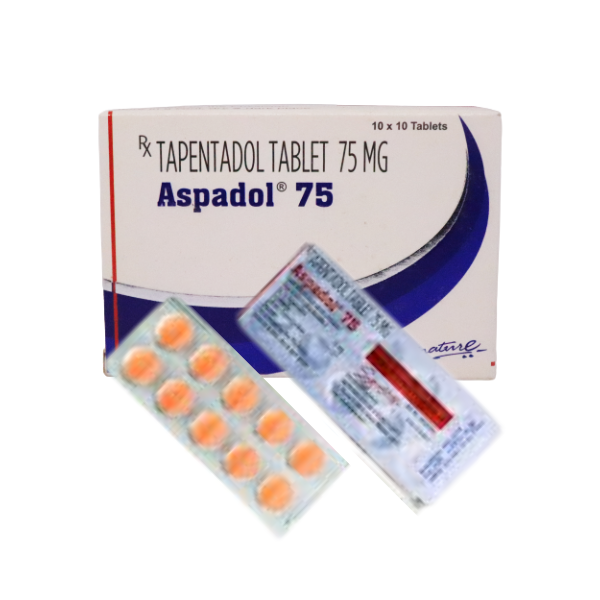Post-surgical pain is a significant concern for patients and healthcare providers alike. Effective pain management is crucial not only for patient comfort but also for promoting faster recovery and preventing complications. Aspadol 75 mg, a medication containing Tapentadol as its active ingredient, has emerged as a reliable solution for managing post-surgical pain. This article explores the top 10 surgeries that often require Aspadol 75 mg for pain management, providing a comprehensive understanding of its benefits, mechanism of action, dosage, side effects, and precautions.
What is Aspadol 75 mg?
Aspadol 75 mg is a prescription medication designed to treat moderate to severe pain. Its active ingredient, Tapentadol, is a centrally acting analgesic that combines two mechanisms of action: mu-opioid receptor agonism and norepinephrine reuptake inhibition.
This dual-action approach makes the Aspadol tablet highly effective in managing pain while minimizing some of the side effects commonly associated with traditional opioids.
Tapentadol, the key component of Aspadol, is also marketed under the brand name Nucynta. However, Aspadol has gained widespread recognition due to its affordability, efficacy, and accessibility. Aspadol 75 mg is particularly effective for managing post-surgical pain, making it a preferred choice for patients and healthcare providers alike.
How Does Aspadol 75 mg Work?
Aspadol 75 mg stands out from other painkillers due to its unique dual mechanism of action. This combination allows it to provide powerful pain relief while addressing the limitations of traditional opioids. Here’s how it works:
- Mu-Opioid Receptor Agonism: Tapentadol binds to the mu-opioid receptors in the central nervous system (CNS), altering the brain’s perception of pain. This mechanism is similar to that of traditional opioids like morphine or oxycodone but is often better tolerated by patients.
- Norepinephrine Reuptake Inhibition: Tapentadol also inhibits the reuptake of norepinephrine, a neurotransmitter involved in the body’s natural pain modulation pathways. By increasing norepinephrine levels, Aspadol enhances the body’s ability to manage pain, providing additional relief.
This dual-action approach not only makes Aspadol highly effective but also reduces the risk of certain side effects, such as respiratory depression, which are more common with traditional opioids.
Top 10 Surgeries That Require Aspadol 75 mg for Pain Management
Post-surgical pain can vary significantly depending on the type of surgery. Here are the top 10 surgeries that often require Aspadol 75 mg for effective pain management:
1. Orthopedic Surgeries
Orthopedic surgeries, such as joint replacements (e.g., hip or knee replacements) and fracture repairs, often result in severe post-operative pain. Aspadol 75 mg provides effective pain relief, allowing patients to engage in physical therapy and regain mobility more comfortably.
2. Abdominal Surgeries
Abdominal surgeries, including hysterectomies, appendectomies, and hernia repairs, can cause significant pain. Aspadol 75 mg helps manage this pain, enabling patients to move and recover more comfortably.
3. Spinal Surgeries
Spinal surgeries, such as laminectomies or spinal fusions, are often associated with intense pain. Aspadol 75 mg provides effective pain relief, improving the patient’s quality of life during recovery.
4. Cardiac Surgeries
Cardiac surgeries, such as coronary artery bypass grafting (CABG) or valve replacements, can cause significant post-operative pain. Aspadol 75 mg helps manage this pain, allowing patients to focus on their recovery.
5. Thoracic Surgeries
Thoracic surgeries, such as lung resections or esophagectomies, often result in severe pain. Aspadol 75 mg provides effective pain relief, enabling patients to breathe and move more comfortably.
6. Gynecological Surgeries
Gynecological surgeries, such as ovarian cyst removals or cesarean sections, can cause significant post-operative pain. Aspadol 75 mg helps manage this pain, allowing patients to recover more comfortably.
7. Urological Surgeries
Urological surgeries, such as prostatectomies or nephrectomies, often result in severe pain. Aspadol 75 mg provides effective pain relief, enabling patients to recover more comfortably.
8. Plastic and Reconstructive Surgeries
Plastic and reconstructive surgeries, such as breast augmentations or rhinoplasties, can cause significant post-operative pain. Aspadol 75 mg helps manage this pain, allowing patients to recover more comfortably.
9. Neurosurgical Procedures
Neurosurgical procedures, such as craniotomies or tumor removals, often result in severe pain. Aspadol 75 mg provides effective pain relief, improving the patient’s quality of life during recovery.
10. Major Trauma Surgeries
Major trauma surgeries, such as those required for multiple fractures or internal injuries, often result in severe pain. Aspadol 75 mg provides effective pain relief, enabling patients to recover more comfortably.
Dosage and Administration
The dosage of Aspadol 75 mg depends on the severity of the pain, the patient’s medical history, and their response to the medication. Key points to consider include:
- Initial Dose: For most patients, the initial dose is 50 mg to 75 mg taken orally every 4 to 6 hours as needed for pain. The dose may be adjusted based on the patient’s tolerance and pain level.
- Maximum Daily Dose: The maximum daily dose should not exceed 600 mg to 700 mg, depending on the patient’s condition and the prescribing physician’s instructions.
- Administration: Aspadol tablets should be swallowed whole with water. They should not be crushed, chewed, or split, as this can lead to rapid release of the drug and increase the risk of side effects.
- Duration of Use: Aspadol is typically prescribed for short-term use, especially for acute pain. Prolonged use may lead to dependence or tolerance.
Patients should always follow their healthcare provider’s instructions regarding dosage and administration to ensure safe and effective pain management.
Side Effects of Aspadol 75 mg
Like all medications, Aspadol 75 mg may cause side effects in some patients. Common side effects include:
- Nausea and Vomiting: These are among the most frequently reported side effects, especially during the initial days of treatment.
- Dizziness and Drowsiness: Aspadol can cause dizziness or drowsiness, which may impair the patient’s ability to perform tasks requiring alertness.
- Constipation: Opioid-induced constipation is a common issue, but it can often be managed with dietary changes or laxatives.
- Headache: Some patients may experience headaches while taking Aspadol.
- Dry Mouth: This is a relatively mild side effect that can be managed by staying hydrated.
While these side effects are generally mild and manageable, patients should seek medical attention if they experience severe or persistent symptoms.
Conclusion
Aspadol 75, with its active ingredient Tapentadol, is a powerful and effective painkiller for managing post-surgical pain. Its unique dual mechanism of action provides potent pain relief while minimizing some of the side effects associated with traditional opioids. When used as prescribed, Aspadol tabs can significantly improve the quality of life for patients recovering from surgery.
However, like all medications, the Aspadol tablet must be used with caution. Patients should follow their healthcare provider’s instructions carefully and be aware of the potential risks and side effects. By doing so, they can safely and effectively manage their pain and focus on their recovery.













